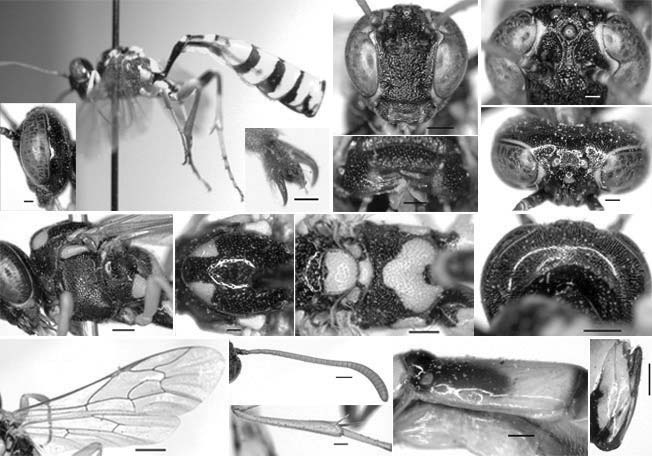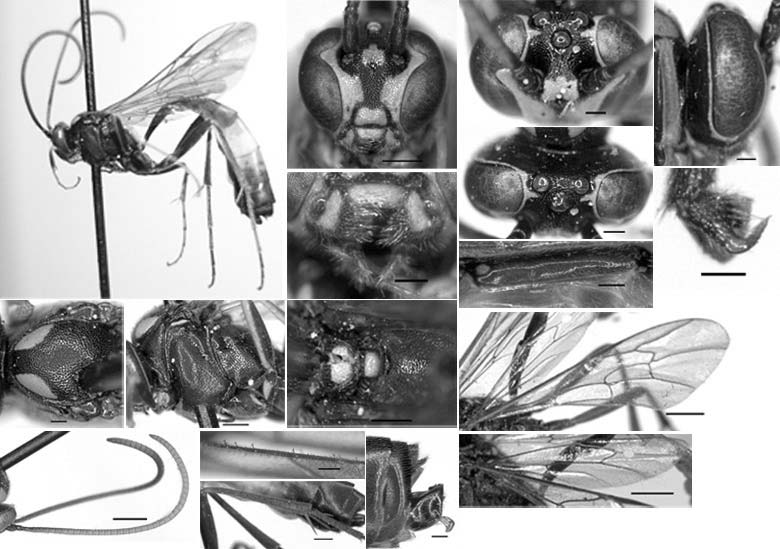



The genus
This small genus has been included as a member of the tribe Hellwigiini within the Campopleginae (Ashmead, 1900; Schmiedeknecht, 1914; Ceballos, 1925; Meyer, 1926; Townes et al., 1965; Townes, 1970; Kasparyan, 1981). But, Kirchner (1867) and Szepligeti (1905a) recognized this genus as a member of the subfamily Ophiononae. On the other hand, Gaulle (1908) insisted that it belongs to the tribe Anomalonini and Enderlein (1912) placed it in the tribe Gravenhorstiini of the Anomaloninae. This genus is currently recognized as the independent subfamily Campopleginae (Wahl, 1991, 1999;Yu and Horstmann, 1997; Belshaw and Quicke, 2002). However, Quicke et al. (2005) suggested that this subfamily designation is inappropriate, based on morphological, molecular, and simultaneous analyses. Recognizing the variety of opinions concerning the systematic position of the genus
The biology of the
The two extant species of the genus
Materials were collected by sweeping. They have been deposited in the animal systematic laboratory of Yeungnam University (YNUE), Gyeongsan, Korea. Some specimens examined in this study are acquired on loan from the Zoologisches Museum, Invalidenstrasse (ZMHU), Berlin, Germany. Specimens were examined by stereo microscope (Zeiss Stemi SV 11 Apo; Carl Zeiss, Gottingen, Germany) and key characters shown in photographs were produced with a Delta imaging system (i-Delta 2.6; iMTechnology, Daejeon, Korea).
Abbreviations are as follows. TD, type depository; TS,type species; HINZ, Zoologisches Staatssammlung, Munchhausenstrasse 21, D-81247 Munchen, Germany (R. Hinz collection); IZU, Instytut Zoologiczny Universytetu, Sienkiewicza 21, Wroclaw, Poland (Gravenhorst collection); TMA, Termeszettudomanyi Muzeum Allattara, Barossa-Utea 13, Budapest H-1088, Hungary; GG, Gyeonggi-do.
Order Hymenoptera
Family Ichneumonidae Latreille, 1802
1*Genus Hellwigia Gravenhorst, 1823
Diagnosis.
Key to the extant species of genus Hellwigia Gravenhorst in the world
1. Apical part of antenna strongly swollen (Figs. 1M, 2A);temple weakly convex (Figs. 1G, 2E); metasoma reddish brown, basal part of each tergites black (Fig. 2A)????????????????????????????????????????????????????????????????????????????????
- Antenna normal, not strongly swollen at apically (Fig.3M); temple flat (Fig. 3F); metasoma black, 3-4 tergites reddish brown (Fig. 3A) ???????????????????????????????
Hellwigia elegans Gravenhorst, 1823 (Figs. 1, 2)
Materials examined. [Voucher] 1♀, Deutschland, #11402; 1♂, Deutschland, Pohlarien, Gerstaecker; 1♀, Schmiedeknecht.
Description (female). Color: Head black; scape and pedicel
blackish brown, antenna yellowish brown, clypeus black,labrum dark blackish brown; mandible black basally, brown apically; malar space yellow, upper orbit of eyes narrowly yellow; labial palp and maxillary palp yellow; mesosoma black, upper part of prepectus with yellow spot; tegula and lower part of tegula yellow; mesonotum black with two yellow spot anterolaterally (Fig. 1I); scutellum and postscutellum yellow in dorsal view; propodeum mostly yellow except anterolaterally (Fig. 1J); fore leg yellow, except coxa black;mid leg yellow, except coxa black ventrally; hind coxa black ventrally, with yellow spot dorsally, trochanter yellow, with black spot dorsally, trochantellus yellow, femur yellow, inner part of femur with brown spot, tibia and tarsus yellow; petiole black except apical yellow, metasoma yellow, with black band basally; ovipositor sheath yellow and apical part black.
Head: Face rugosely, roughly punctuate (Fig. 1D); frons with weakly two vertical ridges (Fig. 1E); vertex closely finely punctate; occiput flat and polished, occipital carina complete (Fig. 1K); temple weakly convex, finely slightly punctate, with short hair; clypeus weakly convex, broad and truncated, not separated from face (Fig. 1D); mandibles long,stout and sharp, broad basally and curved; upper tooth longer than lower (Fig. 1F); labial palp with 4 segments and maxillary palp with 5 segments; inner margins of eyes weakly convergent ventrally; antenna socket opposite to inner margin of eyes very strong dent; ocelli small; antenna very strongly swollen at apically (Fig. 1M), antenna with 29 flagellomeres.
Mesosoma: Pronotum with loose punctures, upper part convex, upper part flat and lower part rugosely reticulated and impressed; mesonotum convex, loosely irregulatly punctuate, notauli absent (Fig. 1I); upper part of mesopleuron convex, loosely punctuate, mesopleural suture with indentations; speculum cancave and with transverse stripe, mesopleural pit absent; prepectal carina, epicnemial carina, and postpectal carina present; sternaulus absent; scutellum loosely slightly punctate; lateral carina strongly complete; postscutellum broader than high (Fig. 1J); metapleuron closely punctuate, with very strong pit; propodeum loosely punctuate,rugosely punctuate, propodeal spiracle large, long crescent shape, connected to pleural suture; propodeum carina absent (Fig. 1J); legs slender; all tibia broad with short spine (Fig. 1N), hind tarsi with spine ventrally; hind tarsal claw simple and strongly curved (Fig. 1C); basal vein of fore wing distad to nervulus, postnervulus with one bulla; 1st recurrent vein and 2nd recurrent vein with one bulla, 1st intercubitus absent; hind wing nervellus intercepted medially, discoidella present (Fig. 1L), hind wing with discontinuous 8 distal hamuli.
Metasoma: Slender; petiole without lateral carina, glymma absent, polished; spiracle located to middle behind of petiole; thyridium circle and impressed; separated from base of 2nd tergite by about less than half of its diameter (Fig.1O); ovipositor short, ovipositor sheath as long as tergite deep (Fig. 1P).
Male (similar to female except for the following). Color:Head reddish brown; scape and pedicel yellow (Fig. 2B), impressed area of antenna sockets black, ocelli area black; antenna yellow; vertex and temple black; surrounded margin of eyes reddish brown; clypeus reddish brown; labrum brown;mandible reddish brown, apical part dark brown; labial palp
and maxillary palp yellowish brown; mesosoma reddish brown, pronotum black (Fig. 2H), tegula yellow; mesonotum reddish brown three black line (Fig. 2N); mesopleurum yellow, with black spot; speculum yellow; scutellum and postscutellum yellow in dorsal view; propodeum reddish brown,basal part black, area of pleural carina black (Fig. 2J); fore leg and mid leg yellow; hind leg yellow to reddish brown, hind trochanter with black line dorsally; petiole black, postpetiole yellow; metasoma reddish brown; clasper of male brown.
Head: Ocelli area very convex; mandible short and blunt, upper tooth as long as lower (Fig. 2C); antenna with 30 flagellomeres.
Mesosoma: Lower part of pronotum with transverse stripe,impressed; speculum convex and with transverse stripe; pleural carina of propodeum present.
Metasoma: Clasper of male broad and short (Fig. 2P).
Distribution. Austria, Bulgaria, Czechoslovakia, France, Germany, Hungary, Iran, Israel, Kazakhstan, Norway, Poland, Romania, Russia, Spain, Sweden, Ukraine.
1*Hellwigia obscura Gravenhorst, 1823 (Fig. 3)
Materials examined. Korea: 1♂, GG, Yongmunsan, 1 Sep 1980, Jang KS; [Voucher] Germany: 1♂, Berghausen, 4 Sep 1927, Hohndorf; 2♂, Schmiedeknecht.
Description (male). Color: Head yellow, face black spot medially; scape and pedicel dark brown, antenna yellowish brown; vertex and temple black; internal space of antenna sockets black, middle area of antenna sockets yellow; surrounded margin of eyes yellow; clypeus yellow, surrounded margin of clypeus black; labrum yellow; mandible yellow basally, dark brown medially, labial palp and maxillary palp yellowish brown; mesosoma black, upper part of prepectus with yellow spot; tegula black and lower part of tegula yellow; mesonotum black with two yellow spot basally; scutellum and postscutellum yellow in dorsal view; fore coxa yellow dorsally, black ventrally, trochanter yellow, trochantellus brown, femur yellow dorsally, dark brown ventrally, tibia and tarsi brown; mid coxa to femur black ventrally, yellow dorsally, tibia and tarsi yellow; hind coax to femur black,tibia and tarsi dark brown; petiole and 2nd tergite black, with yellow spot apical-dorsally, thyridium yellow; 3-4 tergites reddish brown, 5-8 tergites black; clasper of male black.
Head: Face loosely, finely punctate; frons with two vertical ridges; vertex rugosely punctate; occiput flat and polished,occipital carina complete; temple flat, finely slightly punctate, with short hair; clypeus convex and truncated, separated from face by black line (Fig. 3B); mandibles short and stout, broad basally; upper tooth longer than lower (Fig. 3E), with long hairs; labial palp with 3 segments and maxillary palp with 4 segments; inner margins of eyes weakly convergent ventrally; antenna socket opposite to inner margin of eyes very strong dent; ocelli small; antenna normal, not strongly swollen at apically (Fig. 3M), antenna with 46 flagellomeres.
Mesosoma: Pronotum with loosely strong punctures, upper part convex, lower part reticulated and impressed; mesonotum convex, loosely finely punctuate, notauli absent (Fig. 3I); upper part of mesopleuron convex, loosely finely punctuate,mesopleural suture with indentations; speculum flat and subpolished, mesopleural pit weakly present; prepectal carina,epicnemial carina, and postpectal carina present; sternaulus absent; scutellum slightly punctate; lateral carina strongly complete; postscutellum broader than high; metapleuron very loosely punctuate, with very strong pit; propodeum loosely punctuate basally, rugosely punctuate apically, propodeal spiracle large, long oval, connected to pleural suture;propodeum carina absent; legs slender; all tibia with short spine (Fig. 3O), hind tarsi with spine; hind tarsal claw simple and strongly curved (Fig. 3H); basal vein of fore wing distad to nervulus, postnervulus with one bulla; 1st recurrent vein and 2nd recurrent vein with one bulla, 1st intercubitus absent (Fig. 3L); hind wing nervellus intercepted medially, discoidella present (Fig. 3Q), hind wing with discontinuous 6 distal hamuli.
Metasoma: Slender; petiole without lateral carina, glymma absent, spiracle located to middle behind of petiole; thyridium circle and impressed (Fig. 3G); separated from base of 2nd tergite by about half of its diameter.
Distribution. Korea (new record), Austria, Belgium, Bulgaria, Croatia, France, Germany, Hungary, Italy, Mongolia, Romania, Yugoslavia.
Korean name: 1*거짓왕자루맵시벌속 (신칭) Korean name: 1*거짓왕자루맵시벌 (신칭)



